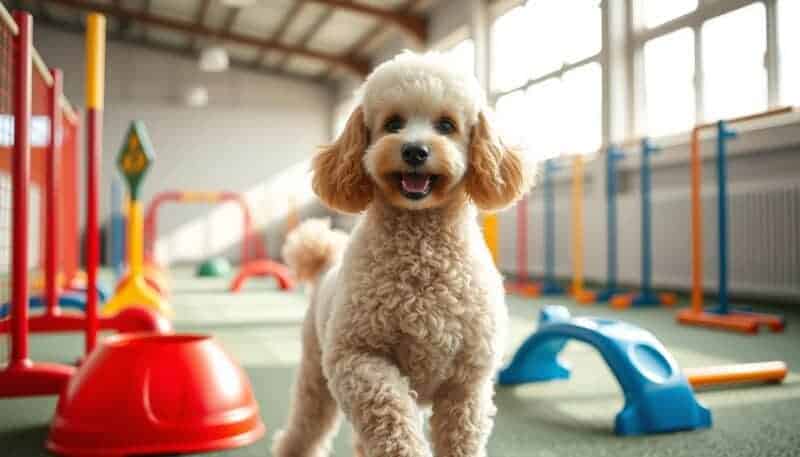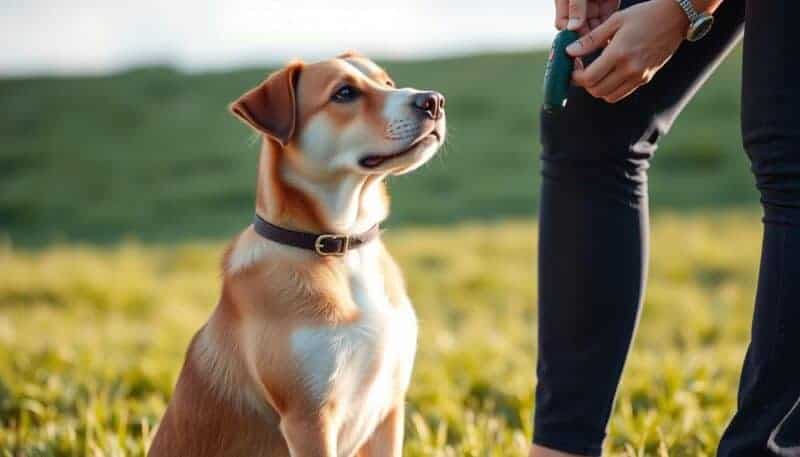Introduction
Understanding What Makes a Dog Easy to Train
Intelligence and Trainability Factors
The Role of Breed-Specific Traits
Age and Training Success Correlation
The Golden Retriever: America’s Favorite Family Dog
Golden Retrievers are also very gentle and loving. They can get along with other children and adults. This makes them perfect for families.
To get the most out of a Golden Retriever, start training early. Use positive methods and socialize them well. This helps them become well-behaved pets.
| Trait | Golden Retriever Characteristics |
|---|---|
| Intelligence | Highly intelligent and eager to please |
| Temperament | Gentle, affectionate, and great with families |
| Trainability | Exceptional obedience training abilities |
| Socialization | Thrives on positive interactions with humans |
The Golden Retriever is a favorite in American homes. They are easy to train and love being part of a family. If you’re looking for a great family dog, the Golden Retriever is an excellent choice.
Labrador Retrievers: Intelligent and Eager to Please
Labrador Retrievers are a favorite breed known for their friendly nature and great trainability. They come from a long line of working dogs in Newfoundland, Canada. Originally, they helped fishermen by retrieving game from the water, showing great focus and obedience.
Working Heritage and Learning Capacity
The Labrador Retriever’s background makes them eager to learn and please. Their intelligence and desire to work well make them quick to pick up new skills. They especially respond well to positive training methods like puppy training and clicker training.
Training Methods That Work Best
- Positive reinforcement: Labrador Retrievers love praise, treats, and rewards, making this a great way to train them.
- Clicker training: The sound of a clicker helps Labradors learn what behaviors are wanted, speeding up their learning.
- Consistency and patience: Labradors do best with training that is consistent and done gently and patiently.
Exercise Requirements and Training Sessions
Labrador Retrievers are extremely active and require plenty of physical and mental activity. Daily exercise and training help keep them happy and strong. It also helps to build an enduring bond between the dog and their owner.
| Exercise Recommendation | Training Session Frequency |
|---|---|
| 60-90 minutes of daily exercise, including walks, playtime, and swimming | 2-3 short training sessions per day, each lasting 10-15 minutes |
Knowing about the Labrador Retriever’s background, best training methods, and exercise needs helps them reach their full potential. They become well-behaved and eager-to-please companions.
Poodles: Smart and Highly Responsive Companions
Poodles are among the easiest dogs to train. They are very smart and respond well to positive training. Their eager nature and problem-solving skills make them great in many training areas, like obedience and agility.
Poodles are known for their high trainability. They are very intelligent and love to please their owners. This makes them perfect for positive reinforcement training. By using treats, praise, or playtime, you can teach them and strengthen your bond.
- Poodles do well in obedience trials, mastering complex commands.
- They are also good at agility, showing off their speed and problem-solving.
- Their playful and eager nature makes them great for learning tricks.
Consistent, positive training is key for poodles. Tailoring your training to their learning style helps them excel in obedience, agility, and more. This makes them truly exceptional easy to train dogs.

“Poodles are like sponges, soaking up everything you teach them. With patience and positive reinforcement, you can mold them into obedience champions.”
German Shepherds: Dedicated Learning Partners
German Shepherds are known for their smarts, trainability, and loyalty. They are perfect for dog training guides and obedience training. This breed loves to learn and can become your best learning buddy.
Mental Stimulation Needs
German Shepherds are very smart and full of energy. They require a lot of mental challenges to keep healthy and happy and well-behaved. Training, puzzle toys, and different activities keep them curious and sharp.
Basic Command Training Guide
- Begin with simple commands like sit, stay, come, and heel. Use treats and praise to encourage good behavior.
- After mastering the basics, add commands like down, roll over, and fetch. This builds on their skills.
- Make obedience training a daily part of your German Shepherd’s life. It should be fun and rewarding.
Advanced Training Possibilities
Once your German Shepherd knows the basics, you can try more challenging training. Agility, herding, or search and rescue training are great. They use their natural abilities and strengthen your bond.
| Training Area | Benefits |
|---|---|
| Agility Training | Improves coordination, problem-solving, and teamwork between you and your German Shepherd. |
| Herding Training | Allows your German Shepherd to engage their natural herding instincts, providing mental and physical stimulation. |
| Search and Rescue | Taps into your German Shepherd’s keen sense of smell and problem-solving skills, making them invaluable search and rescue partners. |
By knowing what German Shepherds need and can do, you can unlock their full potential. They become loyal and well-trained friends.
Easy to Train Dogs for Apartment Living
The right dog breed to live in an apartment can be a challenge. But, with the right training, even small spaces can be perfect for your dog. Some breeds are especially good for apartment living.
The Poodle is known for being smart and easy to train. This makes it a great choice for apartment dwellers. Poodles are full of energy and love to please their owners. They don’t shed a lot and are therefore ideal for apartments.
The Bichon Frise is another breed that’s great for apartments. They are playful and love people. They learn quickly with positive training and don’t need much grooming.
- Poodle
- Bichon Frise
- Shih Tzu
- Cavalier King Charles Spaniel
- Havanese
Other breeds like the Shih Tzu, Cavalier King Charles Spaniel, and Havanese are also good for apartments. They’re calm, flexible and simple to train.
Training your dog for apartment living should focus on positive reinforcement. Use clicker training and treats to reward good behavior. This builds a strong bond and ensures your dog is well-behaved in your small space.
| Breed | Trainability | Apartment Suitability |
|---|---|---|
| Poodle | Highly Trainable | Excellent |
| Bichon Frise | Highly Trainable | Excellent |
| Shih Tzu | Moderately Trainable | Good |
| Cavalier King Charles Spaniel | Moderately Trainable | Good |
| Havanese | Highly Trainable | Excellent |
“With the right positive reinforcement training approach, even small-space dwellers can welcome a furry friend into their homes.”
Border Collies: The Overachievers of Dog Training
Border Collies are known as the “overachievers” in dog training. They are extremely clever and filled with energy. This makes them great for many training tasks.
Herding Instincts and Training Applications
Border Collies are great at herding because of their natural instincts. They can control and move other animals well. Training them in herding or agility can use their talents.
Mental Exercise Requirements
Border Collies need a lot of mental challenges. They love to learn and solve problems. Using dog behavior modification and reward-based training techniques keeps them happy and prevents bad behavior.
Training Challenges to Consider
Training a Border Collie can be tough. They have lots of energy and focus. Owners need to give them lots of exercise to keep them happy.
Knowing how to train a Border Collie is key. It lets owners enjoy a rewarding experience with their dog.
Essential Training Tools and Techniques
Effective dog training goes beyond than simply giving commands. It’s about building a strong bond and understanding your dog. Using the right tools and techniques helps your dog learn better. Whether you’re new to dog ownership or have experience, learning the basics can greatly improve your training.
Clicker Training: A Positive Reinforcement Approach
Clicker training can be a well-known method of training dogs. It uses a clicker to mark the exact moment your dog does something right. Then, you reward them. This makes training more fun and efficient for both you and your dog.
Utilizing Treat-Based Rewards
Treats are a great motivator in dog training. Small, high-value treats can reinforce good behavior. When used with positive reinforcement, they help your dog learn faster and more happily.
Incorporating Clicker Training with Treat-Based Rewards
Using both clicker training and treat rewards is the best approach. The clicker marks the right action, and the treats reward it. This powerful combination makes training fun and effective for your dog.
Additional Training Aids and Techniques
- Positive Reinforcement: Praise, affection, and other forms of positive reinforcement can be highly motivating for your dog.
- Lure-Reward Training: Using a treat or toy to lure your dog into a desired position, then rewarding the behavior.
- Shaping: Rewarding successive approximations of the desired behavior, gradually shaping your dog’s actions.
- Dog training guides: Consulting reputable resources and expert-curated guides can provide valuable insights and techniques.
Training is a journey that requires patience, consistency, and adaptability. By mastering essential tools and techniques, you’ll build a strong bond with your dog. This bond will be rewarding for both of you.

| Training Tool | Description | Benefits |
|---|---|---|
| Clicker | A small handheld device that produces a distinctive “click” sound | Precisely marks the desired behavior, facilitating faster learning |
| Treats | High-value, bite-sized rewards for your dog | Motivates and reinforces desired behaviors, making training more effective |
| Positive Reinforcement | Praise, affection, and other forms of rewarding your dog | Builds a strong, positive bond and encourages continued learning |
Creating an Effective Training Schedule
Creating a consistent training schedule is key for new dog owners. It helps with basic commands and advanced tricks. A good routine makes a big difference in training your puppy.
Daily Training Routines
Experts say to spend 10-15 minutes training your dog each day. Break it into shorter sessions to keep your pup focused. Training at the same time every day helps your dog get ready.
Progress Tracking Methods
It’s important to track your dog’s progress. Use a training journal to log their performance. This will help you determine the things that are working and what needs improvement in your puppy training plan.
Adjusting Training Intensity
As your dog gets better, you can make training harder. Add new commands, increase the time, or add distractions. Always watch your dog’s energy and focus. Be ready to change your training to fit their needs.
With a good training schedule, you’ll build a strong bond with your dog. It’s all about obedience and trust.
| Training Session | Duration | Focus |
|---|---|---|
| Morning | 10-15 minutes | Basic commands (sit, stay, come) |
| Afternoon | 5-10 minutes | Socialization and environmental desensitization |
| Evening | 10-15 minutes | Advanced tricks and obedience |
“Consistent, positive reinforcement training is the key to unlocking your dog’s full potential. Be patient, stay dedicated, and enjoy the journey!”
Common Training Mistakes to Avoid
As a new dog owner, it’s key to know common training mistakes. One big error is using punishment too much. This can damage the trust of your dog and can result in bad behavior. Instead, use reward-based training to teach good habits.
Another mistake is being too inconsistent. Dogs love routine and clear rules. Make sure everyone in your home uses the same commands and rules. This will help your dog to become more adept at learning and avoid confusion.
Finally, many dog owners don’t allow their dogs enough tasks to complete. This can lead to frustration and bad behavior. Breeds like Labradors and Poodles need lots of exercise and brain games. Mix training, play, and fun activities to keep your dog happy and learning.
FAQ:
What is the easiest dog to train?
The easiest dog to train is typically a breed that is intelligent, eager to please, and highly motivated. Easy to train dogs include breeds like the Border Collie, Poodle, and Labrador Retriever
What is the easiest thing to train a dog?
Training a dog to respond to basic commands like “sit” and “stay” is relatively straightforward, especially with consistent practice and positive reinforcement. Breeds such as Border Collies, Poodles, and Labrador Retrievers are particularly adept at learning these commands due to their intelligence and eagerness to please.
What’s the hardest dog to train?
Training a dog can be challenging, especially with breeds known for their independent nature and strong-willed personalities. Breeds such as the Basset Hound, Beagle, and Siberian Husky are often considered more difficult to train due to their stubbornness and strong instincts.
What is the smartest dog?
The Border Collie is widely regarded as the most intelligent dog breed. Renowned for their exceptional problem-solving abilities and quick learning, they excel in various canine activities. Their intelligence makes them highly trainable, often mastering new commands with minimal repetition.
What factors contribute to a dog’s trainability?
A dog’s trainability depends on several things. Intelligence, breed traits, and age are key. Smart breeds like Golden Retrievers and Labradors learn fast.
Also, a dog’s personality affects how well they learn. Their temperament and how they respond to training are important.
How do I choose a dog breed that is easy to train?
Look for breeds known for being smart and eager to please. Golden Retrievers, Labradors, and Poodles are great choices. They do well with positive training.
German Shepherds and Border Collies are also good. They learn quickly and enjoy training.
What are the best training methods for easy-to-train dog breeds?
Positive reinforcement works best for these breeds. Clicker training and rewards are effective. Consistent and patient training builds a strong bond.
It’s also important to keep their minds active. Tailor training to their needs for the best results.
How do I create an effective training schedule for my easy-to-train dog?
Make a consistent training schedule for your dog. Daily sessions, even short ones, are key. They help reinforce commands and build obedience.
Keep track of your dog’s progress. Adjust the training as needed. Regularly review and update the schedule for success.
What are some common training mistakes to avoid with easy-to-train dog breeds?
Avoid inconsistent training and punishment-based methods. These can confuse and discourage your dog. Stay positive and patient.
Focus on rewarding good behavior. Remember, every dog is different. Tailor training to meet their needs to avoid overwhelming them.
Share your thoughts in the comments below! If you enjoyed this post, consider subscribing to our newsletter for more pet tips, stories and blogs!

